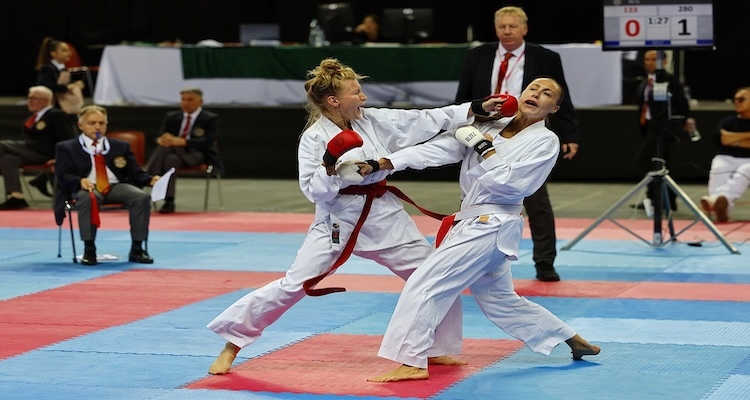
Karate is a traditional Japanese martial art focused on striking techniques using punches, kicks, knee strikes, and open-hand techniques. It emphasizes discipline, focus, and control. Practitioners, called karateka, train to develop physical strength, agility, and mental fortitude. Karate originated on the island of Okinawa and evolved from indigenous martial arts influenced by Chinese martial arts. It encompasses various styles, such as Shotokan, Goju-Ryu, and Wado-Ryu. Karate competitions involve katas (choreographed patterns of movements) and kumite (sparring). Belts symbolize the practitioner's level of proficiency, with advancement earned through rigorous training and testing. Karate fosters self-defense skills, self-confidence, and personal growth.
While karate offers numerous physical and mental benefits, practitioners are not immune to injuries. The dynamic nature of karate, involving intricate movements, strikes, and blocks, puts participants at risk of various injuries. Understanding these common injuries is crucial for practitioners, coaches, and healthcare professionals to develop effective prevention strategies and ensure a safe training environment.
Strains and sprains are among the most prevalent injuries in karate. These occur when muscles or ligaments are stretched beyond their usual limits, leading to pain, swelling, and restricted movement. The rapid, forceful movements involved in karate, such as kicking and twisting, can strain muscles and ligaments, especially in the lower limbs. Ankles, knees, and hamstrings are particularly susceptible. Proper warm-up exercises, stretching routines, and gradually increasing intensity levels can help reduce the risk of strains and sprains.
Contusions, commonly known as bruises, are another frequent occurrence in karate. They result from blunt force trauma to the body, typically during sparring or practicing techniques. Punches, kicks, and blocks can inadvertently cause bruising, particularly in areas with less protection, such as the arms, thighs, and torso. While bruises are often minor and heal relatively quickly, repeated impacts can lead to more significant injuries or discomfort. Wearing appropriate protective gear, like padded gloves and shin guards, can mitigate the risk of contusions.
Although less common, fractures and other bone injuries can occur in karate, particularly during high-impact activities or when executing techniques improperly. The hands, feet, and ribs are vulnerable areas due to their exposure during strikes and blocks. Fractures may result from direct impacts, excessive force, or improper landing techniques. Proper technique instruction, adequate supervision, and gradual progression in training intensity are essential for reducing the likelihood of bone injuries. Additionally, ensuring proper conditioning and strengthening exercises can enhance bone density and resilience.
Karate places significant demands on the joints, making them susceptible to various injuries, including dislocations and cartilage damage. Rapid changes in direction, sudden stops, and forceful impacts can strain or hyperextend joints, particularly in the knees, elbows, and shoulders. Joint injuries often result from improper alignment, overextension, or excessive force during movements. Practicing proper form, maintaining flexibility through regular stretching, and incorporating strength training exercises can help stabilize the joints and reduce the risk of injury.
Overuse injuries, such as tendonitis and stress fractures, can develop gradually over time due to repetitive motions and excessive training without adequate rest. Karate practitioners may experience overuse injuries in the wrists, elbows, knees, and ankles, primarily from repetitive striking, blocking, and pivoting movements. Symptoms may include pain, swelling, and decreased range of motion. To prevent overuse injuries, practitioners should incorporate rest days into their training schedule, vary their exercises to avoid repetitive strain, and listen to their bodies to recognize early signs of overuse.
Head and facial injuries, while less common in karate than in contact sports like boxing or MMA, can still occur, especially during sparring or competitive matches. Blows to the head can result in concussions, facial lacerations, or dental injuries. Proper protective equipment, such as headgear and mouthguards, is essential for reducing the risk of head and facial injuries. Additionally, strict adherence to rules and regulations regarding contact levels and techniques in sparring can help minimize the likelihood of accidental head trauma.
Soft tissue injuries, including strains, sprains, and contusions, can affect muscles, tendons, and ligaments throughout the body. These injuries often result from sudden movements, overstretching, or direct impacts. In karate, soft tissue injuries may occur during rapid kicks, twists, or sudden changes in direction. Adequate warm-up and cool-down routines, along with proper technique instruction, can help prevent soft tissue injuries by preparing the muscles and connective tissues for activity and promoting flexibility and resilience.
In conclusion, while karate offers numerous physical and mental benefits, practitioners must be aware of the potential risks of injury associated with the sport. Understanding common injuries and their underlying causes is crucial for implementing effective prevention strategies and maintaining a safe training environment. By prioritizing proper technique, adequate warm-up and cool-down routines, appropriate protective equipment, and gradual progression in training intensity, karate practitioners can minimize the risk of injury and enjoy the many rewards that this ancient martial art has to offer.
This blog does not not offer medical or health advice and you should always consult a qualified healthcare professional about any injury prevention and/or management strategies. If you want to find a specialist to consult do search our easy to use directory to find a sports physiotherapist, chiropractor, sports therapist, or osteopath near you.
